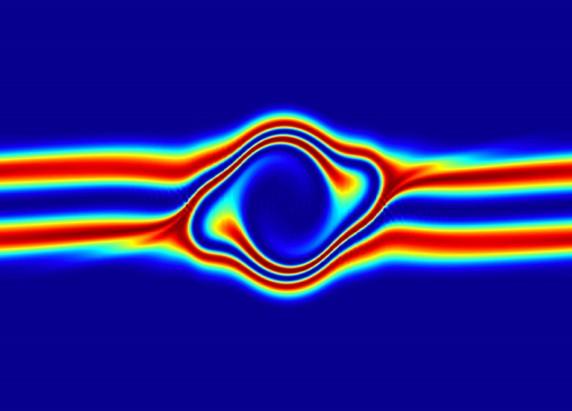
Credit: David L. Green/Oak Ridge National Laboratory, U.S. Dept. of Energy
Fusion – Squeezing the code
The prospect of simulating a fusion plasma is a step closer to reality thanks to a new computational tool developed by scientists in fusion physics, computer science and mathematics at Oak Ridge National Laboratory.
Harnessing fusion power on Earth requires strong magnetic fields to hold and squeeze a super-heated gas, and the large scale experiments capable of such extreme conditions can take decades to build.
Through simulation, a team led by ORNL’s David Green hopes to perform virtual investigations of how fusion devices behave using high-performance computing.
“The mathematics underlying a fusion plasma are so complex that traditional approaches test the limits of even today’s largest supercomputers,” Green said. The team has tested a new approach on ORNL’s Summit supercomputer and they expect that its combination with ORNL’s upcoming exascale Frontier supercomputer will make a virtual fusion device possible.
Media Contact: Sara Shoemaker, 865.576.9219; [email protected]
Image: https:/
Caption: This simulation of a fusion plasma calculation result shows the interaction of two counter-streaming beams of super-heated gas. Credit: David L. Green/Oak Ridge National Laboratory, U.S. Dept. of Energy
Modeling – Efficient infrastructure mapping
A novel approach developed by scientists at Oak Ridge National Laboratory can scan massive datasets of large-scale satellite images to more accurately map infrastructure – such as buildings and roads – in hours versus days.
Comprehensive image data is useful for stakeholders to make informed decisions. The new computational workflow uses deep learning techniques to train and deploy models to better address location, environmental and time challenges when mapping structures.
“We developed a framework that divides the labor of characterization among several models, each tasked to learn to detect specific objects under near-homogeneous contexts versus one model attempting to detect objects under diverse conditions across a collection of images,” said ORNL’s Dalton Lunga who led the study.
The team tested the approach on 21 terabytes-worth of image data (one terabyte covers about 12,085 square miles) and reduced the computing time from 28 days to about 21 hours.
Next, they will characterize even larger image datasets on ORNL’s Summit supercomputer.
Media Contact: Sara Shoemaker, 865.576.9219; [email protected]
Image: https:/
Caption: A new computational approach by ORNL can more quickly scan large-scale satellite images, such as these of Puerto Rico, for more accurate mapping of complex infrastructure. Credit: Maxar Technologies and Dalton Lunga/Oak Ridge National Laboratory, U.S. Dept. of Energy
Computing – Assessing mental health
Oak Ridge National Laboratory will partner with Cincinnati Children’s Hospital Medical Center, collaborating with CCHMCs’ Dr. John Pestian and Dr. Tracy Glauser, to explore ways to deploy expertise in health data science that could more quickly identify patients’ mental health risk factors and aid in suicide prevention strategies.
ORNL and CCHMC will leverage the lab’s expertise in high-performance computing – which includes access to the world’s most powerful supercomputers – and proven ability to keep medical records safe and secure to research new computational methodologies using deep learning and artificial intelligence techniques.
“Our collaboration’s goal is to quickly scan and detect at-risk patients’ behaviors and predictive patterns that could lead to mental health solutions, all while keeping personal information protected,” said ORNL’s Joe Lake.
After the pilot phase, the team plans to scale up to larger patient datasets and share the results with other entities that have identified mental health conditions as a top priority, such as the National Institutes of Mental Health and the Department of Veterans Affairs.
Media Contact: Sara Shoemaker, 865.576.9219; [email protected]
Image: https:/
Caption: ORNL’s collaboration with Cincinati Children’s Hospital Medical Center will leverage the lab’s expertise in high-performance computing and safe, secure recordkeeping. Credit: Genevieve Martin/Oak Ridge National Laboratory, U.S. Dept. of Energy
Batteries – Charged up on sodium
Researchers at Oak Ridge National Laboratory demonstrated that sodium-ion batteries can serve as a low-cost, high performance substitute for rechargeable lithium-ion batteries commonly used in robotics, power tools, and grid-scale energy storage.
Sodium-ion batteries, or SIBs, show promise beyond lithium-ion batteries because sodium’s abundance makes it more affordable compared to lithium. However, limitations in the technical design of their anode, cathode and electrolyte systems prevent SIBs from being widely used.
In a study, ORNL researchers developed SIBs by pairing a high-energy oxide or phosphate cathode with a hard carbon anode and achieved 100 usage cycles at a one hour charge and discharge rate.
“The dedication to lithium-ion batteries over the past 20 years has eclipsed any significant development around room temperature sodium-ion batteries despite the material availability,” ORNL’s Ilias Belharouak said. “This research shows how SIBs can be designed for improved performance.”
Media Contact: Jennifer Burke, 865.576.3212; [email protected]
Image: https:/
Caption: ORNL researchers developed sodium-ion batteries by pairing a high-energy oxide or phosphate cathode with a hard carbon anode and achieved 100 usage cycles at a one-hour charge and discharge rate. Credit: Mengya Li/Oak Ridge National Laboratory, U.S. Dept. of Energy
###
Media Contact
Sara Shoemaker
[email protected]
865-576-9219
Related Journal Article
http://dx.




